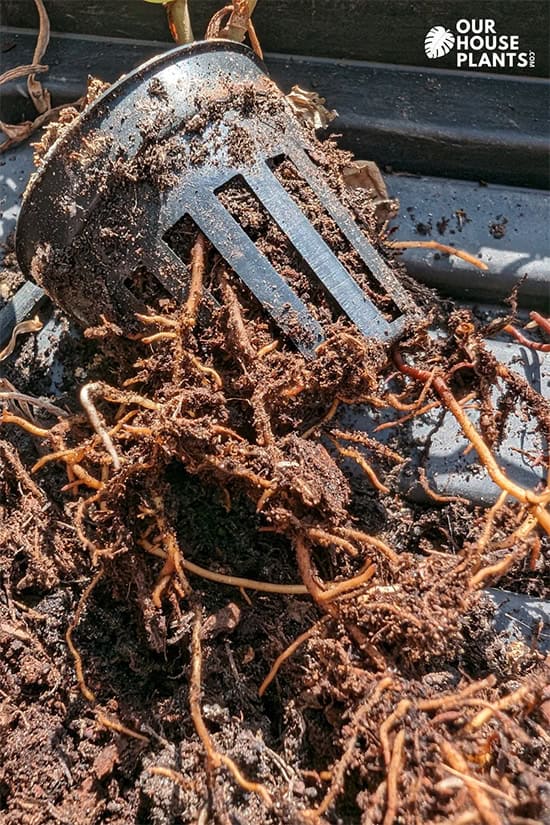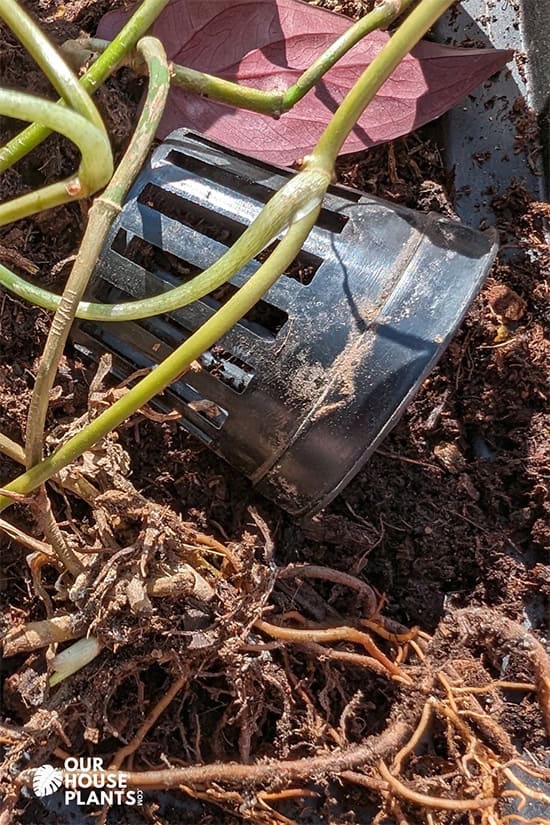When it comes to growing houseplants, ensuring they have a healthy root system is one of the most important things for their overall well-being and longevity in your home.
Indoor gardeners, both new and experienced, will at some point encounter root cages, mesh or fabric wrapped around the plant's roots. Owners will often first glimpse them when they decide to repot their plants. So can they be left alone or do they need removing?
A Net Pot or Root Mesh like you can see here, is quite common. So what is it for? Does it help or hinder the plant?
Whether you need to remove them or not depends on a couple of factors that I'll take a look at. Read on to learn whether you need to remove the plastic cages that surround the roots on some plants, the pros and cons of these materials, as well as my recommendation about what you should do when you come across them.

Hi, I'm Tom!
If you're like me and enjoy the challenge of growing houseplants and getting them to thrive, then Ourhouseplants can help. This website shares my knowledge and years of growing plants and provides (hopefully) helpful advice on properly caring for your indoor plant friends.
Why are root mesh and plastic cages even a thing in the first place? Well, in most cases they're used to contain and protect the root systems of young plants, particularly during transport and the initial growth stages in the first year or so of their lives. They help maintain the integrity of the root ball and provide support to the plant.
These are the common things you may find surrounding or wrapped around the roots.
Those "cages" are often nicknamed as a "death trap" because they restrict and prevent the roots from spreading naturally into the surrounding soil.
There is a common misconception that often the material, especially the fabric, is biodegradable so will eventually rot or decompose without you having to do anything.
However in most cases the material is cheap plastic, non-biodegradable string, metal wire or fabric that isn't a degradable material. In fact, these pots will quite often be around longer than you'll have the houseplant.
I've seen other websites and people suggesting these cages have long term benefits for houseplants and can help create long term healthy root growth. In reality they don't. I mean think about it, how can they really?
There are no scientific studies or scientific evidence that suggests using wire baskets or cages are beneficial to older plants. It's almost a certainly that root bound plants, or those that have root development restricted in some way, will always have stunted growth above the soil.
After all, this is why it's recommended to use a form of root restriction for garden plants at the planting site when you don't want them to spread or grow too wild, like with the herb mint for example.
The truth of it is that the primary benefits of using root mesh and plastic cages come to the houseplant grower while raising the plants for sale and not after. Here's why.
Indirectly, mesh and cages do have benefits and advantages for us as consumers. If the overheads for the growers are lower, we're likely to find better and more reasonable prices in shops when buying plants.
Although roots can and will grow through the holes, they're still being restricted compared to plants without the mesh and this can negatively influence and reduce the future growth of the plant.
Roots will still grow through the holes, but plants with unrestricted growth tend to grow much better in the long term. So it's my view that root mesh, fabric, plastic cages or (whatever awful contraption has been used), should be removed from most houseplants whenever the opportunity arises.
What's my Final Verdict?
Remove those bad boys as soon as you can! They can only cause problems for plants in the longer term. So unless there is a compelling reason to keep them. Get them off your plants!
It doesn't have to be done as soon as you get them home. But once the plant has started to establish and is of a decent size it's worth thinking about.
For small plants and baby plants, removing the mesh or cage early on can actually be beneficial. Doing it allows their roots to spread freely in their juvenile stages when they're establishing. This lets them grow taller, faster and generally provides better health for the plant.
For larger plants or trees in large root cages, the decision may depend on the specific circumstances and the plant's growth stage. For example, I saw a giant rubber tree in a tight wire basket. However, the roots had grown through the holes, and trying to remove the basket without damaging the roots wasn't feasible.
If you've decided to remove the mesh or cage then it may be as simple as puling the plant out of it.
In other instances, it may have started to grow through the holes or slats, making it more difficult. The plant may also be wrapped in tight fabric or even have a collar around the stems.
If this is what you're finding, then it's time to dig out the scissors, pruning shears, or even a pair of pliers to help break the plant free. These tools can all be used to cut through plastic mesh, synthetic burlap, or thin wire cages.
After years of being in this cage, this Syngonium is finally free and can develop into a healthy plant. I moved it into a larger pot, used a fresh potting mix with organic matter for added nutrients. After a couple of weeks it was clearly happy with the changes as I saw new growth.
Once the plant is free, you can repot it into a similar potting mix to what it was growing in previously. Because of the previous restriction, the roots may be very concentrated at the base of the stem. If that's the case, gently spread the roots out a little before repotting them.



